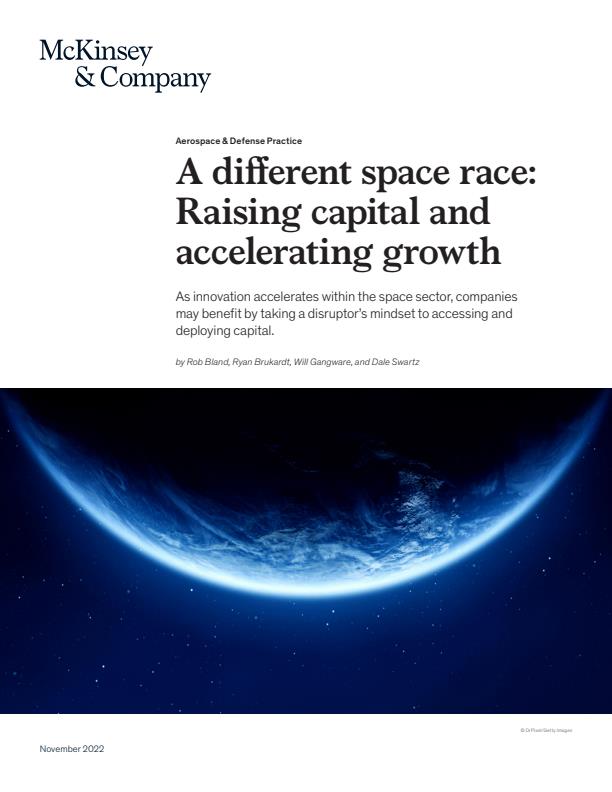In recent years, money has been pouring into the space sector. Take 2021, when public and private markets put $10 billion of fresh capital to work in space companies. These investments are fueling a new wave of dynamism and innovation throughout the space ecosystem, with downstream impacts on the competitive landscape that could increase challenges for some companies.
The growing dynamism of the space industry is driving shifts in customer behavior. Major civilian and military customers are seeking to move more quickly and shift more risk to industry partners than they did in the past. They also increasingly favor commercial-like models in which partners invest up front to develop and own intellectual property (IP). For example, the US Department of Defense’s Space Development Agency is trying to leverage existing commercial IP to field a large constellation of communications and missile-tracking satellites in low Earth orbit (LEO).1
Meanwhile, a rising number of new entrants in the space sector have tapped into this significant and growing investor interest to pursue spin-offs, partnerships, and private-investment rounds. These entrants have used the wave of private and public capital to fund their product road maps and become first movers in an expanding set of commercial opportunities in space.
Given the rapid growth in funding, which has accelerated innovation and led to more competition, winning business strategies are also changing fast. Players looking to build or maintain market leadership in the space sector may benefit from embracing a disruptor’s mindset—identifying creative ways to access and deploy capital while delivering value to core customers by staying ahead of the curve on both capabilities and business models. This mindset will become even more important as macroconditions shift and investors raise the bar for deploying capital into higher-risk ventures.
Space investment has been rocketing higher
Over the past decade, the space sector has experienced massive growth in investment activity. Between 2012 and 2021, total annual investment grew to more than $10 billion, from $300 million. Through the first half of 2022, investment lagged behind 2021 but remained quite high by historical standards, indicating that the sector may prove resilient despite the challenges of the current market environment.
LEO ventures have attracted the most interest and funding from investors, with small-satellite-constellation ventures proliferating and increased competition in the small-satellite-launch market driving down launch costs. Investor interest has also been driven by greater awareness of the variety of promising near-term LEO use cases, including telecom and Earth observation. LEO ventures may increasingly serve as proof-of-concept precursors for higher-altitude ventures, including those at cislunar distances and beyond. With advances in enabling technologies for deep-space activities, such as launch services and in-space infrastructure, investors may look beyond LEO for the next frontier of investment opportunities. Several customer and investor signals point to cislunar space as a key growth opportunity in the next decade.
Space companies have multiple ways to access capital
Space companies have used five main strategies to access capital in recent years: private-venture funds, spin-offs, partnerships, special-purpose acquisition companies (SPACs), and internal investment and R&D.
Private-venture funds
Venture capital (VC) investments in the space sector have grown substantially over the past decade as investors have come to appreciate the long-term commercial potential of the industry. The many active VC investors in the space sector include Andreessen Horowitz, Founders Fund, and Lux Capital. Much of the capital has flowed to early-stage companies, allowing space start-ups with less mature products or a longer path to profitability to fund R&D of capital-intensive products while working to capture early customer revenue.
For example, Astranis Space Technologies raised a $250 million series C round satellites at a $1.4 billion valuation in April 2021 for smaller, less expensive, geostationary communication.2 Relativity Space attracted $650 million in a financing round to scale production for its fully reusable, entirely 3-D-printed Terran R rocket in June 2021.3 ABL Space Systems raised $200 million at a $2.4 billion valuation in October 2021 to scale production for low-cost satellite launch vehicles.4 In May 2022, SpaceX raised $1.5 billion at a $125 billion valuation for the development of the Starlink broadband, satellite-based internet system, in addition to its Starship rocket.5
Would you like to learn more about our Aerospace & Defense Practice?
Although VCs continued to invest in the space sector in the first half of 2022, companies faced intensifying competition for investments from top-tier VC backers. Based on our discussions with ten leading VC companies, we found that those space companies that have had recent success in attracting funding from VCs are more likely than other companies to undertake the following activities:
- Targeting large and growing addressable markets with near-term revenue potential from public and private customers. With all of the inherent risks and uncertainties tied to the space sector, companies going after the biggest current or future segments, such as launch vehicles, satellites, and spacecraft, have a clearer path to generating the significant growth and magnitude of returns that VCs like to see. One surveyed VC cited a minimum benchmark of ten to 15 times ROIC for space ventures—and potentially, much higher returns for riskier bets.
- Creating proprietary or unique tech. Given the capital-intensive nature of space products, VCs like to see that companies have the proprietary and unique tech to achieve clear differentiation and a strong “competitive moat” to prevent future market share erosion.
- Employing proven leadership teams. Start-ups with seasoned executive team members who bring deep industry knowledge, technical expertise, and prior entrepreneurial experience have a significant edge in attracting VC capital. Space is a particularly difficult market to enter for novice entrepreneurs.
- Showing clear commercial applications. While NASA and the US Department of Defense remain the largest customers in the space sector, their budgets grow slowly. It takes many years for a new venture to build relationships and credibility with the government, and legacy contractors typically retain a significant share of government spending on space. Many successful space start-ups are distinguished by their ability to gain traction in both commercial and governmental markets.
- Using innovative business models to meet customer needs. For the reasons we described, business models for early-stage space companies that rely on traditional government contracts are increasingly rare. Instead, successful space start-ups often employ business models emphasizing flexibility and affordability that appeal to a broad range of government and commercial customers.
- Demonstrating speed and customer traction. As macroconditions shift and capital becomes more expensive, the bar for space ventures to obtain funding will continue to rise. The ventures that can move quickly to become cash positive with less reliance on up-front capital will strengthen their ability to attract investment in the current market.
Spin-offs
When large legacy companies spin off new space ventures, the spin-offs gain the ability to operate with greater agility and independence while still benefiting from the parent companies’ resources, expertise, and relationships. Sierra Nevada cited these considerations in its decision to spin off its space division into a stand-alone company subsequently known as Sierra Space.6
Even space companies themselves may find that the spin-off strategy makes sense. See, for instance, Virgin Galactic’s decision to spin off its LauncherOne rocket program into Virgin Orbit to create a separate entity that could better focus on serving the booming small-satellite industry.7
Partnerships
Partnerships with investment companies can allow space sector players to accelerate the development of their corporate venture arms and improve their ability to move quickly on promising investment opportunities. Such partnerships also benefit investment companies, which can gain access to the space company’s industry connections, technical expertise, and capabilities to support the growth of portfolio companies.
For example, the aerospace private-investment company AE Industrial Partners partnered with Boeing to manage HorizonX, Boeing’s venture capital fund.8 The two organizations subsequently deepened their partnership in a July 2022 announcement on the launch of a second HorizonX venture fund, with the goal of raising $250 million to invest in promising start-ups in digital enterprise applications, future mobility, networks, security, space, and sustainability.9
Even the US government sees the value of partnering with investment companies to spur innovation in the sector. In October 2021, the US Space Force and the VC company Embedded Ventures announced an agreement to collaborate on R&D opportunities to promote the growth of the US space industry.10
Special-purpose acquisition companies
In 2021, SPAC deals in the space sector increased dramatically in frequency and scale. For example, in July 2021, Astra went public via SPAC at a $2.1 billion valuation to develop rockets for affordable satellite delivery missions.11 Momentus Space went public via SPAC in August 2021, raising approximately $250 million at a $567 million valuation to offer last-mile space delivery and infrastructure services, including in-space transportation, hosted payloads, and in-orbit services. Spire Global went public via SPAC in August 2021 at a $1.6 billion valuation that raised $265 million in cash.12 And Planet Labs went public via SPAC in December 2021, raising more than $500 million at a $2.8 billion valuation to provide Earth observation imagery and analytics.13 Since the fourth quarter of 2021, however, the SPAC market in the space sector has significantly cooled.
Internal investment and R&D
Larger, more established space players with substantial cash on their balance sheets can use their internal resources to invest in the next wave of space capabilities. For example, Northrop Grumman operates a wholly owned subsidiary called SpaceLogistics to provide cooperative space logistics and in-orbit-satellite servicing to geosynchronous satellite operators. After the acquisition of satellite manufacturer Blue Canyon Technologies in 2021, Raytheon Technologies invested in building new manufacturing facilities, which opened in August 2022, to expand its in-house commercial and defense satellite production capacity.14
Space companies can use capital to accelerate innovation and fuel growth
The abundance of private and public capital flowing into commercial space enables several key growth strategies. Space ventures can deploy capital to gain share of high-growth space segments through M&A. To boost organic growth, space players can use material capital raises to pull forward innovation and product development by several years. Additionally, capital can provide innovative space companies with the flexibility to invest in leading-edge products and IP. This can in turn unlock innovative new business models (for example, as-a-service models) to provide additional value to core government customers. Last, players can invest to strengthen key relationships with suppliers and customers.
Use M&A to scale in fast-growth segments
Broadly speaking, there are two M&A growth strategies that space companies leverage to drive growth. Some companies use M&A to advance their goals of becoming a one-stop shop through horizontal expansion or vertical integration. For instance, Redwire has employed an M&A strategy to build a comprehensive portfolio of capabilities in satellite design and production, as well as in-orbit services. In November 2021, it acquired Techshot, a microgravity biotech company that has been printing human tissue aboard the International Space Station.15 Voyager Space has used M&A to increase its vertical integration and mission capability with acquisitions of satellite component company Space Micro and propulsion tech company Valley Tech Systems.16
Other space companies use M&A to bolster their capabilities within a specific end market. That’s the approach that Planet Labs has taken in the Earth observation market. In 2017, it acquired satellite constellation assets to bolster its Earth observation coverage by purchasing Terra Bella from Google.17 More recently, Planet Labs has pursued M&A with software- and data-focused players, such as VanderSat, to bolster its downstream data and analytics capabilities for Earth observation.18
Boost organic growth through product innovation
Not all expansion or integration occurs via M&A. Many space leaders and disruptors have focused on organic growth by funding in-house tech and engineering teams to design and build next-gen products. Companies able to create their own groundbreaking products or capabilities often see less value in acquiring companies whose technologies may lag behind what they already possess than in accelerating their internal product road maps.
For example, SpaceX has invested heavily into the quick development and launch of Starlink after realizing that it could leverage proven capabilities from its launch business toward deploying a broadband-satellite-based internet system. SpaceX announced that it would invest $10 billion to build out Starlink.19 Rocket Lab used the success of its launch vehicle to raise a $140 funding round in 2018. The company then used some of this funding to develop its Photon spacecraft to provide customers with an affordable integrated solution for payload delivery. Rocket Lab’s CEO subsequently touted Photon’s role in delivering a launch and lunar mission for NASA at the relatively low price of $10 million.20

R&D for space: Who is actually funding it?
Invest in strengthening customer and supplier relationships
Space players have also deployed capital to invest in customer and supplier relationships via up-front purchases, exclusive deals, and other favorable partnerships. These agreements can provide needed up-front capital and improve the stability of early-stage suppliers. Simultaneously, they help the space companies making the investments secure advantageous deal terms and ensure sufficient capacity.
For instance, KSAT entered into an exclusive agreement with Rocket Lab to provide ground station services to all Rocket Lab launch customers, giving it a long-term customer base of small-satellite launchers. Similarly, Capella Space invested in an exclusive relationship with AWS Ground Station to download satellite imagery and data directly into Amazon Web Services. The partnership allows Capella Space to provide real-time data to customers without having to invest in its own ground stations or other infrastructure.21
The space sector is quickly evolving, as seen by the surge in investment in recent years and the range of strategies that space players have used to secure and deploy private capital. Given the recent volatility of public markets and the well-publicized struggles of SPACs, private capital may increasingly take center stage in fueling the organic and inorganic growth of space players over the next few years.
Having access to a patient pool of private capital can be a major advantage for players that face long product development timelines in immature markets, and this capital will be crucial to winning market share in the space sector. Space companies seeking investment will have to make a strong case to investors on the appeal of the size of their target markets, the strength of their proprietary tech, the diversity of their customer bases, and the speed of their go-to-market plans. They will also need to embrace a disruptor’s mindset, demonstrating that they can deliver value to core customers through the innovative nature of their capabilities and business models.



